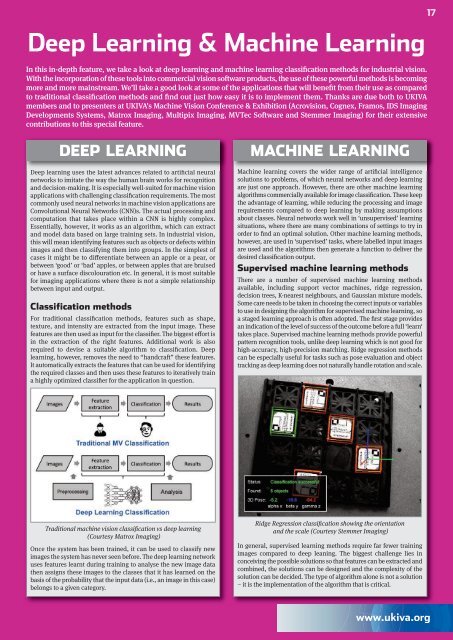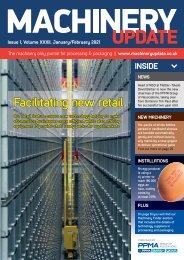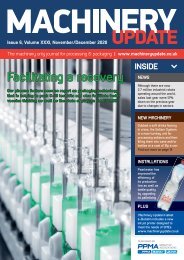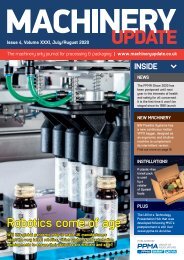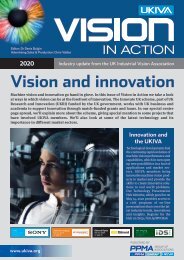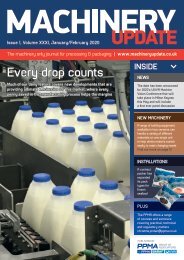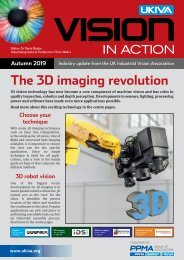VIA Autumn 2018 On-Line
You also want an ePaper? Increase the reach of your titles
YUMPU automatically turns print PDFs into web optimized ePapers that Google loves.
17<br />
Deep Learning & Machine Learning<br />
In this in-depth feature, we take a look at deep learning and machine learning classification methods for industrial vision.<br />
With the incorporation of these tools into commercial vision software products, the use of these powerful methods is becoming<br />
more and more mainstream. We’ll take a good look at some of the applications that will benefit from their use as compared<br />
to traditional classification methods and find out just how easy it is to implement them. Thanks are due both to UKIVA<br />
members and to presenters at UKIVA’s Machine Vision Conference & Exhibition (Acrovision, Cognex, Framos, IDS Imaging<br />
Developments Systems, Matrox Imaging, Multipix Imaging, MVTec Software and Stemmer Imaging) for their extensive<br />
contributions to this special feature.<br />
DEEP LEARNING<br />
Deep learning uses the latest advances related to artificial neural<br />
networks to imitate the way the human brain works for recognition<br />
and decision-making. It is especially well-suited for machine vision<br />
applications with challenging classification requirements. The most<br />
commonly used neural networks in machine vision applications are<br />
Convolutional Neural Networks (CNN)s. The actual processing and<br />
computation that takes place within a CNN is highly complex.<br />
Essentially, however, it works as an algorithm, which can extract<br />
and model data based on large training sets. In industrial vision,<br />
this will mean identifying features such as objects or defects within<br />
images and then classifying them into groups. In the simplest of<br />
cases it might be to differentiate between an apple or a pear, or<br />
between ‘good’ or ‘bad’ apples, or between apples that are bruised<br />
or have a surface discolouration etc. In general, it is most suitable<br />
for imaging applications where there is not a simple relationship<br />
between input and output.<br />
Classification methods<br />
For traditional classification methods, features such as shape,<br />
texture, and intensity are extracted from the input image. These<br />
features are then used as input for the classifier. The biggest effort is<br />
in the extraction of the right features. Additional work is also<br />
required to devise a suitable algorithm to classification. Deep<br />
learning, however, removes the need to “handcraft” these features.<br />
It automatically extracts the features that can be used for identifying<br />
the required classes and then uses these features to iteratively train<br />
a highly optimized classifier for the application in question.<br />
MACHINE LEARNING<br />
Machine learning covers the wider range of artificial intelligence<br />
solutions to problems, of which neural networks and deep learning<br />
are just one approach. However, there are other machine learning<br />
algorithms commercially available for image classification. These keep<br />
the advantage of learning, while reducing the processing and image<br />
requirements compared to deep learning by making assumptions<br />
about classes. Neural networks work well in ‘unsupervised’ learning<br />
situations, where there are many combinations of settings to try in<br />
order to find an optimal solution. Other machine learning methods,<br />
however, are used in ‘supervised’ tasks, where labelled input images<br />
are used and the algorithms then generate a function to deliver the<br />
desired classification output.<br />
Supervised machine learning methods<br />
There are a number of supervised machine learning methods<br />
available, including support vector machines, ridge regression,<br />
decision trees, K-nearest neighbours, and Gaussian mixture models.<br />
Some care needs to be taken in choosing the correct inputs or variables<br />
to use in designing the algorithm for supervised machine learning, so<br />
a staged learning approach is often adopted. The first stage provides<br />
an indication of the level of success of the outcome before a full ‘learn‘<br />
takes place. Supervised machine learning methods provide powerful<br />
pattern recognition tools, unlike deep learning which is not good for<br />
high-accuracy, high-precision matching. Ridge regression methods<br />
can be especially useful for tasks such as pose evaluation and object<br />
tracking as deep learning does not naturally handle rotation and scale.<br />
Traditional machine vision classification vs deep learning<br />
(Courtesy Matrox Imaging)<br />
<strong>On</strong>ce the system has been trained, it can be used to classify new<br />
images the system has never seen before. The deep learning network<br />
uses features learnt during training to analyse the new image data<br />
then assigns these images to the classes that it has learned on the<br />
basis of the probability that the input data (i.e., an image in this case)<br />
belongs to a given category.<br />
Ridge Regression classification showing the orientation<br />
and the scale (Courtesy Stemmer Imaging)<br />
In general, supervised learning methods require far fewer training<br />
images compared to deep leaning. The biggest challenge lies in<br />
conceiving the possible solutions so that features can be extracted and<br />
combined, the solutions can be designed and the complexity of the<br />
solution can be decided. The type of algorithm alone is not a solution<br />
– it is the implementation of the algorithm that is critical.<br />
www.ukiva.org


